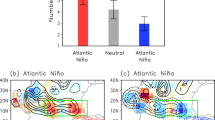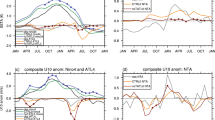Summary
The growth rates of amplifying mid-tropospheric perturbations in tropical North Africa is known to reduce with increased vertical shear in the troposphere. This phenomenon leads to a reduction in the frequency of generation of squall lines – the main rain-producing mechanism in tropical North Africa – because squalls are initiated by amplifying modes of African Easterly Waves (AEW). Ultimately, therefore, tropical North Africa experiences a shortfall, with respect to long-term averages, in annual rainfall. Weakening of AEW intensity is shown to be linked with the warming up to the sea-surface temperatures (SST) of the South Atlantic, Pacific and Indian Oceans. These findings are consistent with the observed reduction in the incidence of intense hurricanes along the entire westem Atlantic in Sahelian dry years. It is shown that the frequency of occurrence of Atlantic tropical storms and hurricanes is unaffected by the dryness or otherwise in the Sahel, but the paths of the storms are determined by the zonal exit point, from the African continental land mass to the Atlantic, of West African disturbance lines. These results have applications, and implications, in the level of preparedness for the economic impacts of Atlantic storms and hurricanes.
Similar content being viewed by others
Author information
Authors and Affiliations
Additional information
Received June 8, 1996 Revised June 8, 2000
Rights and permissions
About this article
Cite this article
Adedoyin, J. SST-induced climate change in tropical North Africa: The intermediary role of lower tropospheric oscillations. Meteorol Atmos Phys 75, 135–147 (2000). https://doi.org/10.1007/s007030070001
Issue Date:
DOI: https://doi.org/10.1007/s007030070001




